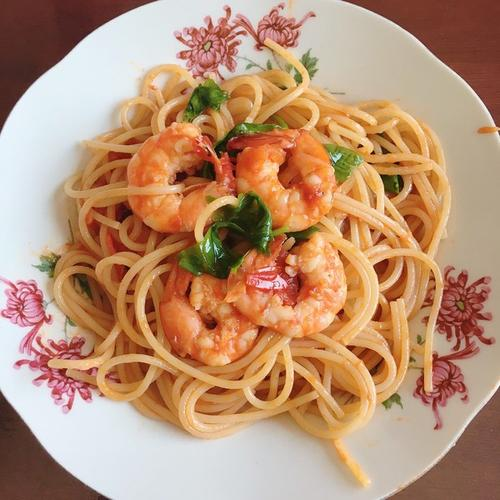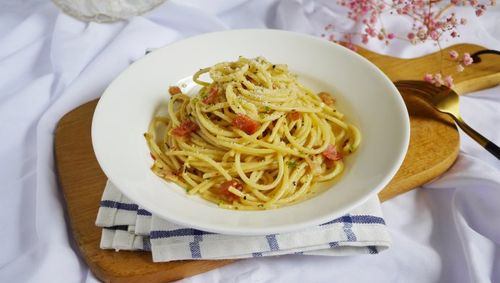意大利面英文介绍
History of PastaNothing says Italy like its food, and nothing says Italian food like pasta. Wherever Italians have immigrated they have brought their pasta and so today it is basically an international staple. Unlike other ubiquitous Italian foods like Pizza and tomato sauce, which have a fairly recent history pasta may indeed have a much older pedigree going back hundreds if not thousands of years. To begin to unravel the long an often complex world of pasta we have to look at its origins and some of the myths surrounding this now worldwide food.Many schoolchildren were taught that the Venetian merchant Marco Polo brought back pasta from his journeys in China. Another version states that Polo discovery was actually a rediscovery of a foodstuff that was once popular in Italy in Etruscan and Roman times. Well Marco Polo might have done amazing things on his journey but bringing pasta to Italy was not one of them, it was already there in Polo's time. There is some evidence of an Etrusco-Roman noodle made from the same durum wheat as modern pasta called "lagane" (origin of the modern word for lasagna). However this food, first mentioned in the 1st century AD was not boiled like pasta, it was cooked in an oven. Therefore ancient lagane had some similarities, but cannot be considered pasta. The next culinary leap in the history of pasta would take place a few centuries later.Pasta TodayIt is estimated that Italians eat over sixty pounds of pasta per person, per year easily beating Americans, who eat about twenty pounds per person. This love of pasta in Italy far outstrips the large durum wheat production of the country; therefore Italy must import most of the wheat it uses for pasta. Today pasta is everywhere and can be found in dried (pasta secca) and fresh (pasta fresca) varieties depending on what the recipes call for. The main problem with pasta today is the use of mass production to fill a huge worldwide demand. And while pasta is made everywhere the product from Italy keeps to time-tested production methods that create a superior pasta.Dried PastaThere are roughly 350 different shapes and varieties of dried pasta in Italy, even more counting regional differences. Shapes range from simple tubes to bow ties (farfalle, which actually means "butterfly"), to unique shapes like tennis rackets (racchette). Many, but not all of these types are usually available wherever pasta is made. By Italian law dried pasta must be made with 100% durum semolina flour and water, a practice that all but the worst quality pasta makers worldwide have since adhered to. However there are two factors in dried pasta from Italy that make it typically better than most other products: extrusion and drying methods.Dried pasta, especially the more complex shapes (such as radiatore) are designed for grabbing and holding onto sauces. Dried tube pasta (ziti or penne) often has ridges or slight abrasions on the surface to hold onto the pasta sauce as well. These ridges and bumps are created during the extrusion process, when the pasta is forced from a copper mold and cut to desired length before drying. These molds, while expensive and prone to wear are favored for making the best dried pasta. However most producers worldwide use steel molds that produce pasta that is too smooth to hold onto sauce. Fortunately more pasta makers outside of Italy are starting to use the older style copper molds.After the pasta is cut it must be dried using a process of specific temperature and time. This is another area where mass produced pasta falls short of good Italian pasta made the correct way. The mass produced pastas are dried at very high temperatures for a shorter time than quality pasta. Traditional pasta is allowed to dry slower, up to 50 hours at a much lower temperature. It is after the pasta is fully dried that it is packaged. The result is a product with a much better mouth-feel, quicker cooking time, and superior sauce holding noodles.materialeggplantpersimmoncomparesthousandmanufacturetomatoesgood-cheukeggplant,persimmonfilament,slantingmaterialcomparesthousandmodulates.

意面的英文是什么?
意大利面英文是spaghetti。
1、把足量的盐水烧开,再放入意大利面条。
Boilplentyofsaltedwater,thenaddthespaghetti.
2、他是煮意大利面条的高手。
He'sadabhandatcookingspaghetti.
3、她吃了三盘意大利面条。
Sheatethreeplatefulsofspaghetti.
4、在色拉中加入意大利面条,增加你的纤维摄入量。
Addpastatoyoursaladstobumpupyourfibreintake.
5、尼古拉斯吃了一盘意大利面条。
Nicholasateadishofspaghetti.
有没有人知道意大利面的英语怎么读和写啊?!
pasta
[ 'pɑ:stə ]

意大利面的英语
spaghetti几种常见的:
1.alphabets - 字母面
通常字母面是用来放在汤里起点缀作用的。
2.macaroni---通心粉
短于4cm才叫通心粉哦,大了就是另外的种类了。
3.rotini ("spirals" or "twists") -螺旋粉.
一般短于4cm。
4.angel hair, capellini ("fine hairs") - 天使面.
细长如发丝,意大利人亲切地称之“天使的发丝”。
5.manicotti - 大通心面(袖筒面)
直径很大,内部可填充馅料。
6.jumbo shells -大扇贝面
内部体积大,可填充馅料。
7.bow ties, farfalle ("butterflies") -蝴蝶结面
因其形状深受女性的欢迎。
8.medium egg noodles (from "nudel," german meaning paste with egg) - 蛋面
9.medium shells, conchiglie ("shells") - 扇贝面
大扇贝面的缩小版,里面不填馅。
10.ditalini----手指面(顶针面)
如同顶针一样的外形。
11.wide egg noodles---宽边蛋面
12.spaghetti --长面
传统的长条形,也是一般意义的“意粉”
13.orzo ("barley") - 粒粒面
饭粒形状。
14.vermicelli---细面
区别于天使面,细面一般短于5cm。
15.fusilli ---弯弯面
类似于螺旋面,不过是长条的。
16.penne, mostaccioli---尖面(斜管面)
区别于通心粉,直径较大,斜截面。
17.wagon wheels, ruote ("wheels") - 园面(小轮面 )
圆形的。
18.lasagne (from "lasanum," latin for pot) -千层面(宽面) .
一层面一层馅焗制,或者拿去包意式云吞,口感独到。
19.radiatore ("radiators") - 层层面
造型别致精巧。
20.ziti ("bridegrooms") - 新郎面.
可以理解为长条形的粗通心粉。
21.linguine ("little tongues") -中细面
形状类似中国的挂面。
22.rigatoni ("large grooved") -粗通心面
样如其名。
意大利面种类之多,分类之严格,造型之别致,口感之独特,无不可以称之为艺术。“pasta 主要指通心粉及面条” ,谢谢提供! spaghetti 是指“意大利细面条”,拉丁文是讲求精确的,不同的面条有不同的说法是可以理解的。
以下是金山词霸2006+的翻译
pasta
[5pB:stE]
意大利面制品, 意大利面食(包括通心粉及面条等)
pasta
pas.ta
AHD:[päs“t…]
D.J.[6p$8st*]
K.K.[6p$st*]
n.(名词)
Paste or dough made of wheat flour, eggs, and water, often formed into shapes and dried and used in a variety of recipes after being boiled.
意大利面制品:由小麦面、鸡蛋和水做成的面糊或面团,通常加工成一些形状并烘干,做熟后可用于种种烹饪
A prepared dish containing pasta as its main ingredient.
意大利面条:一盘已做好,以意大利面制品为主要配料的菜
Italian
意大利语
from Late Latin [paste, pastry cake] * see paste 1
源自 后期拉丁语 [面糊,糕点] *参见 paste1
pasta
/'pAstE; - 'pa:stE; 'pastE/
[U] dried paste made from flour, eggs and water and cut into various shapes, eg macaroni, spaghetti, ravioli 意大利面食(如通心粉、 细面条、 方形饺):
* [attrib 作定语] a pasta dish, eg lasagne 一盘面食(如宽面). Cf 参看 noodle.
spaghetti
[spE5^eti]
意大利式细面条
spaghetti
spa.ghet.ti
AHD:[sp…-gµt“¶]
D.J.[sp*6geti8]
K.K.[sp*6gWti]
n.(名词)
A pasta made into long solid strings and cooked by boiling.
意大利面条:做成长而硬的条并用开水煮食的面糊
Electricity A slender tube of insulating material that covers bare wire.
【电学】 绝缘套管:由绝缘材料制成的裹在裸线上的软管
Italian [pl. diminutive of] spago [cord]
意大利语 [] spago的复数小后缀 [线]
spaghetti
/spE'geti; spE'geti/
[U] Italian pasta made in long thin rods, cooked in boiling water until soft and usu served with a sauce 意大利面条.





